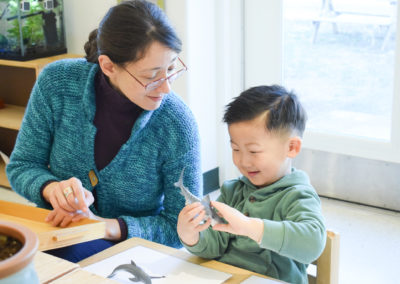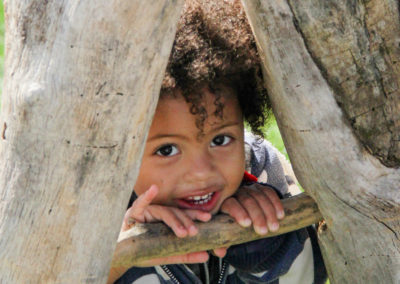

Why Montessori?
Greenspring Montessori School promotes self-paced, collaborative learning to ignite the passion and curiosity of our students. Montessori nurtures the child’s innate desire to learn, allowing them to develop strong academics, leadership, self-discipline, independence, and responsibility – traits they will carry with them through high school and beyond.
For over 50 years, Greenspring Montessori School has built a tradition of serving children implementing the educational philosophy of Dr. Maria Montessori, an Italian physician and pioneer in child development who observed that children have an innate aptitude and desire for acquiring knowledge about their world. Montessori’s approach of “following the child” is at the root of our philosophy at Greenspring Montessori School.
An authentic Montessori environment encompasses the following principles:
- Mixed age groups
A fundamental component of the Montessori philosophy is the multi-age classroom. In a mixed group, children of various ages and backgrounds share their talents and interests. Older children serve as role models and solidify their understanding of their work by giving lessons to younger classmates. Children are exposed to a greater variety of content and are inspired by the work of others. Younger children are embraced by an established classroom community.
- Freedom for children to choose their work and work at their own pace
The Montessori curriculum is deep and broad. Rather than the child conforming to a set program, in which the entire class must complete the same work simultaneously, each child in the Montessori classroom receives the lessons for which he is ready and pursues his own interests. This flexibility allows children the time they need to fully absorb concepts and the ability to pursue work that is both exciting and challenging. - Freedom to explore, make mistakes, and correct them independently
Montessori materials feature hands-on materials that introduce concepts on a concrete level. These early hands-on experiences allow the child to make the leap to a deep and abstract understanding. Most materials include a control of error, allowing the child to check her own work without relying upon an adult.
- Prepared environments for the needs of each age group
Montessori guides design classrooms to meet children’s physical, cognitive and social needs. Child-sized furniture and hands-on materials engage children in independent work. A beautiful ordered work environment allows them to develop internal order and discipline. Open areas and group tables encourage collaboration and teamwork. In the prepared environment, children not only learn but thrive.
- Stewardship of others, the community, and the environment
Peace education and lessons in Grace and Courtesy are two major components of your child’s Montessori experience. Starting in our youngest programs, children learn to respect the work of their peers, speak calmly without interrupting, and care for the other children, animals, and plants in their classrooms. At the older levels, children learn to resolve arguments with one another around a Peace Table and begin to extend their service and stewardship outwards to the greater Baltimore community and the world.
Guiding your Child
Montessori teachers, or as well call them, Guides, go through a rigorous two to three year certification program, on top of their Bachelor’s degree. This training gives them a deep understanding of child development and the specific needs of each child. A Montessori guide must intimately understand each child’s interests, motivations, abilities, and insecurities. It is through observation of the child that a guide ensures that they meet the classroom community as a whole as well as the individual needs of each child.
Accreditation Matters
Greenspring Montessori School is the only Montessori school in the area that is fully accredited by two external organizations – the American Montessori Society and Association of Independent Maryland and DC Schools.
These agencies establish and oversee standards of excellence for Montessori and independent schools. Accreditation is a voluntary and rigorous process that demonstrates an unparalleled level of excellence in the implementation of Montessori education and continuous improvement. Fully accredited schools are held to the highest standards of the authentic educational philosophy and scientifically-based practices of Maria Montessori.

Toddler Community
We offer Young Toddler classrooms for children ages 18 months to 2 years of age, as well as Older Toddler classrooms for children ages 24 months to 3 years of age. You may choose from morning and full day options, as well as three (Monday through Wednesday or Wednesday through Friday), four (Monday, Tuesday, Thursday, Friday), or five days per week.
Take a virtual tour of one of our Toddler classrooms.
Engaging, Meaningful Activity
We are committed to providing our toddlers with engaging, meaningful activities which:
- provide experiences that stimulate the senses
- enrich the child’s vocabulary and understanding of language
- provide time for the child to repeat and master activities
- teach our children how to use tools in the environment such as eating utensils, brooms, sponges, etc.
- give children the opportunity to gain a sense of self-esteem, self-worth, and self-confidence
Learn More about Montessori for Toddlers:
Language Development and Socialization
Children are encouraged to interact with peers by sharing true stories, discussing a meal they are having, and practicing Grace and Courtesy. Lessons of Grace and Courtesy are practiced daily to help toddlers learn to share and be considerate of others.
Independence
Very young children have an innate desire to take care of their own needs. We see the child as an individual, allowing her to set her own pace in pursuit of independence.
Movement
There are specifically designed materials in the classroom that support muscle movement and fine motor exercises for hand-eye coordination.
Practical Life Skills
Practical life exercises such as pouring, sweeping, dusting, buttoning, zipping and table setting are introduced early, providing opportunities for children to care for themselves and their environment.
An eating area includes a place for the children to help with preparation of the food they will eat. This area provides sensory input and real experiences, with real tools for a real purpose.
Photo Gallery
Experience the world through your child's eyes.
The Next Step: The Children’s House Classroom
As the children near age three, they will start to give us signs that they are ready to move up to Children’s House. Language skills will start to develop rapidly; enthusiasm for independence in self-care and other work will grow.
















